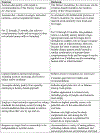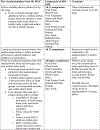Healthy Eating Index-2020: Review and Update Process to Reflect the Dietary Guidelines for Americans,2020-2025
- PMID: 37201748
- PMCID: PMC10524328
- DOI: 10.1016/j.jand.2023.05.015
Healthy Eating Index-2020: Review and Update Process to Reflect the Dietary Guidelines for Americans,2020-2025
Abstract
The purpose of this review is to share the process for reviewing, updating, and developing the most recent version of the Healthy Eating Index-2020 (HEI-2020) for ages 2 and older, following the release of the Dietary Guidelines for Americans (DGA), 2020-2025. The overall review process included: 1) gathering information from the updated DGA, experts, and federal stakeholders; 2) considering substantive changes and needs for new development, keeping in mind the HEI's key features and guiding principles, the US Department of Agriculture's Dietary Patterns that serve as the foundation for the HEI, and scoring considerations; and 3) completing evaluation analyses, including the examination of content validity. The review process led to the development of the HEI-2020; a separate HEI-Toddlers-2020 was developed for ages 12 through 23 months. The 13 components and scoring standards of the HEI-2020 fully align with the HEI-2015, although the index was renamed to clarify that it aligned with the most recent 2020-2025 DGA. As the evidence informing the DGA continues to evolve, various aspects of the HEI may need to evolve in the future as well. Further methodological research is encouraged to add to the scientific evidence base on dietary patterns, to examine needs specific to each life stage, and to model optimal trajectories of healthy dietary patterns over the lifespan.
Keywords: Diet quality; Dietary intake; Healthy Eating Index; diet indices.
Copyright © 2023 Academy of Nutrition and Dietetics. Published by Elsevier Inc. All rights reserved.
Conflict of interest statement
Figures








References
-
- U.S. Department of Agriculture and U.S. Department of Health and Human Services.Dietary Guidelines for Americans, 2020 – 2025.; 2020.
-
- U.S. Department of Agriculture and U.S. Department of Health and Human Services.Process | Dietary Guidelines for Americans.AccessedApril 25, 2022. https://www.dietaryguidelines.gov/about-dietary-guidelines/process
Publication types
MeSH terms
Grants and funding
LinkOut - more resources
Full Text Sources
Medical
Research Materials

